I wanted to review this locomotive for a while, I bought it a year ago. Sadly, as I can’t find time (or the courage) to work on my layout, many of my acquisitions often stay in the box.
This electric locomotive (ref 731272) comes with an integrated sound decoder, and has a very original livery: it’s a toy… painted like a toy in real life.
The story of sound
In 2009 (or 2010), Fleischmann was the first “big” German manufacturer to announce regular N locomotives with an integrated sound decoder. This was hardly a technical first, but it was the first time they bothered to fit the electronic into a single engine. Until now, Fleischmann (and Minitrix) sound-fitted engines were rare in the catalogs, and always came as inseparable double units: one motorized engine and another dummy with sound decoder. Many US manufacturers produce N-sound locomotives, the colossal size of some of these engines does make sound in N much easier though.
Fleischmann has produced this model – a Siemens “Taurus” – with different liveries (Deutsche Bahn and Arriva for Germany, Classic ÖBB & Mozart Livery for Austria…) obviously keeping the same electronic on board. Another model that became available with sound was a Swiss locomotive, available in standard SBB/CFF livery and many other declinations.
As of 2013, they are not announcing many new sound models, but they going to deliver a famous steam engine (the BR 01.10) also with audio goodies. Prices are still steep, and choice still limited, but it’s only a good thing that big manufacturers start gathering the know-how of making large sound models series.
The original
This locomotive belonged to Arriva PLC, an international transport company based in London, operating many services across Europe. But the story doesn’t end here in the wonderful world of privatized railways. Deutsche Bahn purchased the entire Arriva company in 2010, but in order to preserve competition in Germany, the regulators forced the DB to get rid of Arriva’s German services.
This locomotive thus now belongs to…the FS, the italian incumbent railway operator, via its Netinera subsidiary. Easy isn’t it 😉
More down to earth, this locomotive serves the “ALEX” service route (train numbers: ALX….) . This is a porte-manteau for Allgäu-Express, the name of the service when it was operated by the Deutsche Bahn until 2007. In a nutshell: these trains are basically a privatized regional service.
So why is it painted like a toy? This was part of 175th jubilee of the first railway line in Germany.
I have been living in a small Bavarian town for the last year…and I thank railway privatization for giving me the chance to see so many different trains and colors. I rode an ALEX train with this locomotive a few times (getting me closer to Munich Airport).
To my knowledge, there was only one locomotive painted that way (other Arriva engines with light blue colors were all around). Although I am not sure how long they intend to keep this livery, I saw this engine about 4 months ago, still with its colorful design.
Here are two real life pictures from last winter:
Those are smartphone pictures and the quality isn’t good, but on the 2nd picture, at the front of the locomotive, you may notice…a Roco logo. I don’t know how the sponsoring worked, but obviously there is a reason for this weird toy-like livery: a model train manufacturer was behind the scenes!
A few last words about the original.
- Arriva uses what seems to be refurbished DB coaches, painted in blue but with an old-style interior. I won’t complain about it: despite the seats being old-fashionned, the seats are wide and comfortable. For the last year, I have been noticing a shiny new purchase (although it may also be refurbished): a double-floor coach that seems to be only in service between Munich and Regensburg – which is the portion of the line with the most commuters.
- Electric locomotives (such as the one I have here) are used between Munich and Regensburg. Obviously some place up north is not totally electrified, so they do switch engines in Regensburg with a diesel unit before the train moves on.
- Another funny “old” practice: on Arriva-run trains, you can still hop on and buy your tickets with the conductor (though you need to go to him spontaneously if you don’t want to get a fine).
This practice was abandoned a few years ago on Deutsche Bahn trains: you need to buy your tickets at the station (although I don’t: I buy my tickets on my smartphone anyway). - The standard livery for the ALEX service is light blue, as mentioned already. I also have the N 4-coaches set (part no 881203), and here is a real-life picture:
The model
Now finally, a word about the model itself.
The livery doesn’t look serious…just as the original. The first thing that I noticed, was that Fleischmann was quite generous in terms of sound functions (something Minitrix had disappointed me with).
There are about 15 sound functions, and the sound of the original Taurus is rather well rendered. I still need to tweak the decoder settings to allow for a real slow start. If you don’t know already, the Taurus electric locomotive has one of the most distinctive & beautiful engine noise: it sounds like a (somehow sick 🙂 ) church organ when starting. If you haven’t heard it yet I recommend checking the youtube videos here or here.
But back to the model: apparently, Fleischmann has literally used the same electronic board for all its Taurus models. Engine noises with random ventilation or other sounds are very good, even at maximum sound level (this engine can be loud if you want to).
There are 2 long station announcements…unfortunately they are for the ÖBB Austrian models (stations Graz and Salzburg), and pronounced with a heavy Austrian accent. Only the short – generic “train departing” announcement – can pass for a real German announcement for an Alex service.
Below is a picture of my command station, with all the sound and functions options set up:

ESU Ecos II with all the sound functions of the Arriva locomotive (right panel)…and the light functions for the coaches (left panel).
There are however a few sounds that are only present on the DB version of the model, including a mysterious “Meep meep” accelaration noise (as written in the manual), that I won’t have the occasion to hear 🙂
Other functions are pretty standard, although one should note the main headlights and the top front light can be operated independently. All 8 wheels are motorized, and 2 of them are equipped with adhesion rubber bands. That leaves 6 wheels spread over 2 bogies that serve as power feeders, well enough for good behavior on reasonably dirty track.
Conclusion
The catalog price (“UVP” as the German say) €240 is a bit high. On the other hand, such a locomotive would cost around €120-140, and an extra sound decoder another €100.
I always like to get models of the train I have actually been on, so I’m glad I got this one.
Make sure to check the quick video at the top of the article. You’ll notice I have started fitting the Alex coaches with interior lighting (some with Goldcaps elkos), this is still work in progress
External links
- The “ALEX” service official page (in German): http://www.alex.info
- The (outdated) Wikipedia entry on the Allgaü-Express train in English: http://en.wikipedia.org/wiki/Allgäu_Railway_(Bavaria)
- The up to date German wiki entry, with the latest service routes: http://de.wikipedia.org/wiki/Alex_(Zug)



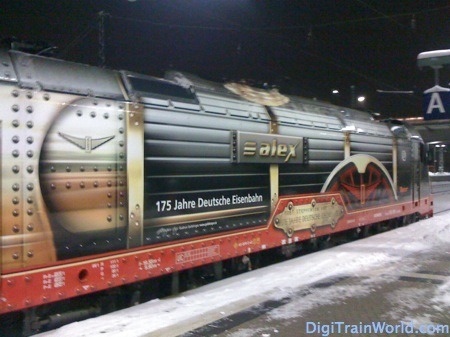
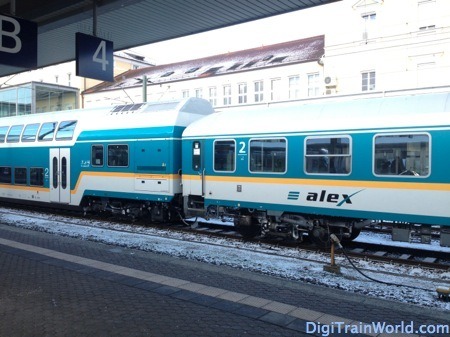

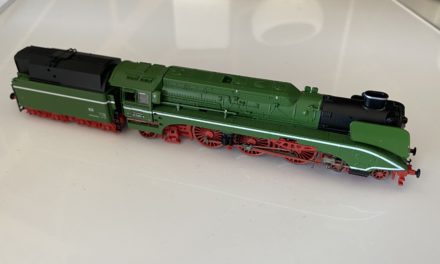
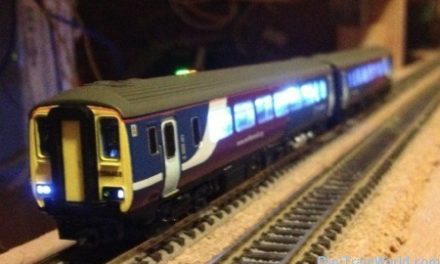
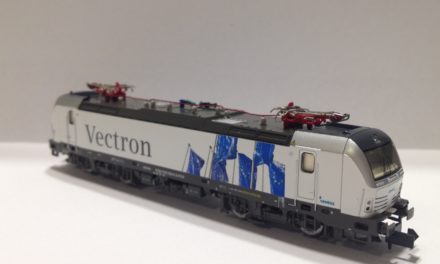



Hi,
A nice review. I just wanted to point out the sound you are after (thyristors on start) is for a BR 182 taurus (or Rh 1016/1116); your model’s sound is correct since it is the 2nd gen taurus BR 183 (Rh 1216) which doesn’t have the “musical” thyristors on start.
For your information Fleischmann don’t implement the BR 182 thyristor start up sound correctly; it doesn’t sync with slow speed correctly and also the tone of the locomotive should change at higher speeds. Also you hear thyristors scaling down in sound in the prototype when coming to a halt. Sadly when they will fix this sound project I don’t know since I have a few first gen taurii from them. If someone will get a project with proper sound done for the Zimo decoders I’d be very happy.
The only companies who do the sound correctly with other makes of decoders is Nusser-Modell and Krois Modell. I have managed to hear one of these makes in action on you tube and sounded fantastic.
Cheers
Thanks a lot for your detailed comment Dimitrios!
I must admit I am not a sound purist myself, but I am glad some pay attention to details for the rest of us.
A nice review of the model. I received one as a farewell gift from my previous department one year ago but have not had the chance to test it. I had a ÖBB Rh1116 which comes with the Fleischmann startset. It sounds great though
Thanks Jimmy, those Fleischmann engines do sound great!